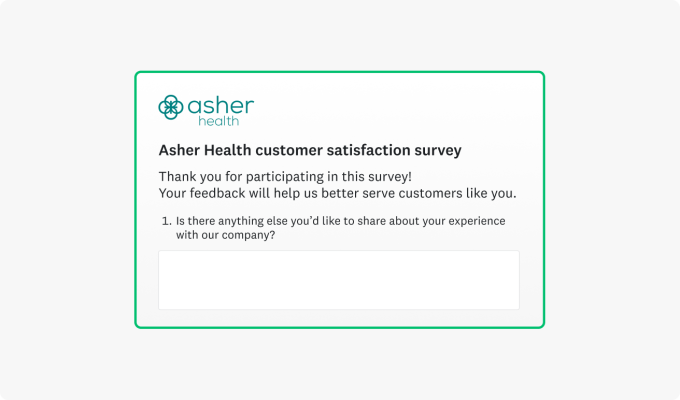What is NPS in healthcare? How to calculate it and why it matters
Practical NPS strategies to enhance patient satisfaction in healthcare. Improve care quality and foster better patient relationships.

No one likes to be admitted to the hospital, yet the need for quality health care is a reality of life. And when patients do need care, it’s critical for the growth and reputation of your healthcare business that their experience is positive.
In fact, recent SurveyMonkey research found that 88% of healthcare executives understand patient experience is somewhat or much more important than before the COVID-19 pandemic.
Patient satisfaction and loyalty are critical factors in healthcare delivery today. Net Promoter Score® (NPS) serves as a key metric that enables healthcare organizations to measure these factors effectively. With the growing emphasis on patient-centered care, NPS has become an invaluable tool for assessing and improving healthcare services.
Beyond simply measuring patient satisfaction, healthcare organizations today need deeper insights into the patient journey. Traditional patient surveys often capture only point-in-time feedback, but NPS provides a forward-looking metric that predicts future patient behavior and loyalty.
In this guide, we'll explore what NPS is, why it matters in healthcare, how to calculate and use it effectively, and strategies to improve your scores for better patient outcomes and business growth.
What is NPS in healthcare?
Net Promoter Score is a customer experience metric that measures how healthcare providers and their services are perceived by your patients.
The question asks patients how likely they are to recommend your healthcare services to friends and family, providing a powerful indicator of patient satisfaction and loyalty. Data collected via Net Promoter Score in healthcare can also provide indicators that are relevant to future growth and success.
Measure your healthcare NPS with our expert-written Net Promoter Score Template.
Why is measuring loyalty important in healthcare?
Patient loyalty plays a crucial role in improving clinical outcomes and revenue growth for healthcare providers. The connection between patient satisfaction and long-term business growth is direct and measurable, with returning patients contributing to clinical success and financial stability.
It's important to note that while traditional customer satisfaction metrics remain valuable, they often fail to capture the emotional connection patients have with their healthcare providers. NPS bridges this gap by focusing on likelihood to recommend, which requires rational satisfaction and emotional loyalty. When healthcare organizations monitor both satisfaction and NPS, they gain a complete picture of the patient-provider relationship that drives long-term sustainability and growth.
Improved patient retention
Regular patients who trust your organization are more likely to return for ongoing care, resulting in consistent revenue streams.
Enhanced patient experience
Returning patients provide valuable feedback. This feedback helps you continuously refine and improve how patients feel about their care experience across all touchpoints.
Increased referrals
Satisfied patients become advocates, referring family and friends to your practice. Word-of-mouth marketing is one of the most effective marketing strategies.
Better patient engagement
Loyal patients are more likely to follow treatment plans, attend follow-ups, and actively participate in their care journey.
Informed decision-making
Patient loyalty data helps healthcare leaders make strategic decisions about service improvements and investments.
Competitive advantage
Understanding and improving loyalty metrics gives you an edge over healthcare competitors who don't prioritize this insight.
Reduced patient attrition
Measuring loyalty helps identify issues before patients leave, allowing you to address concerns proactively.
Financial stability
Returning patients contribute to predictable revenue, making financial planning and growth initiatives more reliable.
Focus on long-term relationships
Measuring loyalty shifts organizational focus from transactional care to building lasting patient relationships.
Stronger brand reputation
Healthcare organizations known for high patient loyalty naturally develop stronger community reputations.
How does NPS work in healthcare?
NPS provides valuable insights for healthcare providers looking to improve patient experiences through a straightforward survey process that can be easily implemented across diverse healthcare settings.
NPS questions
Created in 2003 by Bain and Company, NPS surveys are quick and straight to the point. They ask one simple question: How likely are you to recommend (company X/product Y/service Z) to a friend or colleague?
This core question is typically followed by an optional question for qualitative feedback, such as "What is the primary reason for your score?" This additional question provides context to the numerical rating and helps identify specific areas for improvement.
The NPS question uses a rating system from zero to 10, with higher numbers indicating greater likelihood to recommend. This net promoter score scale is standardized across industries, making it a reliable benchmark for comparing your performance against competitors and industry averages.
Categorizing respondents
Using a rating system of zero to 10, customers fall into one of three categories:
- Promoters (9-10): Promoters are the most loyal and will continue to do business with you. They would recommend your organization and services to others, which ultimately contributes to your company's growth.
- Passives (7-8): Passives are satisfied but not enthusiastic. They are a vulnerable group because despite their positive view of your company, they are open to patronizing competitors.
- Detractors (0-6): Detractors are unhappy customers who would not refer a friend or colleague. They could potentially hurt your company's brand through negative word-of-mouth, online reviews, or comments.
While no one likes to receive negative feedback, consider it a positive that you have identified any problems. You can now set goals—both internally and externally—to enhance and improve patient experiences. Detractors often provide the most valuable constructive feedback that can drive meaningful improvements in your healthcare services.
The power of healthcare NPS lies in its simplicity, but the insights it provides are remarkably nuanced. By tracking the distribution of Promoters, Passives, and Detractors over time, healthcare organizations can monitor shifts in patient sentiment that might not be apparent in overall customer satisfaction scores.
For example, a migration from Detractors to Passives indicates improvement but may not immediately boost your NPS. Similarly, converting Passives to Promoters significantly improves your score but may require strategies different from those addressing Detractor concerns. This nuanced approach to measuring satisfaction allows for more targeted improvements to the patient experience.
How is NPS calculated?
Once you have collected the scores, it is time to calculate your Net Promoter Score. Based on your calculations, you will receive a percentage for each set of respondents (Detractors, Passives, and Promoters). To calculate the percentage, follow these steps:
- Enter all survey responses into a spreadsheet
- Group the responses by Detractors, Passives, and Promoters
- Add up the total responses from each group
- To find the percentage, take the group total and divide by the total number of survey responses
- Subtract the percentage total of Detractors from the percentage total of Promoters. This answer is your NPS score.
The formula to calculate your percentage is:
(Number of Promoters – Number of Detractors) / (Number of Respondents) x 100

Here is an example:
Let's say that you received 100 responses to an NPS survey. From those 100 responses:
- 10 ranged from zero to six (Detractors)
- 20 ranged from seven to eight (Passives)
- 70 ranged from nine to 10 (Promoters)
So, when you calculate the percentages, you get 10%, 20%, and 70%.
Now, subtract the 10% (Detractors) from 70% (Promoters), which gives you 60%.
Remember that NPS scores are given in integers and not percentages, so your score would simply be 60. This number would then fall on a scale of -100 to +100, the higher the number the better the score.
NPS in healthcare typically falls within specific benchmark ranges that vary by specialty and service type.
Benefits of NPS for healthcare providers
NPS is continually being updated as new responses are received so you can track patient perceptions; benchmark against internal and industry averages; and monitor progress to improvements that will boost your score.
This ongoing feedback loop enables a comprehensive understanding of your patients' experiences and expectations, allowing for more targeted improvements.
Identify areas for improvement in patient experience
NPS helps pinpoint specific aspects of your healthcare service that need enhancement to better meet patient expectations. The feedback you receive often highlights critical customer touchpoints that cause frustration or delight, allowing for targeted improvements.
Benchmark against competitors and industry standards
Compare your healthcare NPS score against other healthcare providers to understand your market position and set realistic improvement goals.
Predict patient loyalty and retention
Higher NPS scores correlate with increased patient retention and loyalty, helping healthcare providers forecast patient behavior more accurately.
Assess overall patient satisfaction
Gain comprehensive insights into how satisfied and happy patients are with aspects of your services and care delivery.
Track the impact of changes in services or policies
Measure how operational or policy changes affect patient perception through consistent NPS survey distribution. This allows you to fine-tune initiatives for maximum impact.
Understand patient advocacy
Identify which patients are likely to recommend your services to others, enabling targeted relationship-building strategies.
Identify Promoters for testimonials and referrals
Leverage happy patients for marketing and growth initiatives by inviting them to share their positive experiences.
Improve patient-provider relationships
Higher NPS scores correlate directly with stronger patient-provider relationships, which leads to measurably better clinical outcomes. Patients who feel valued and respected by their healthcare providers demonstrate greater trust, better treatment adherence, and more effective communication about symptoms and concerns.
Measure the effectiveness of patient communication
Evaluate how well your communication strategies resonate with patients to optimize information delivery across all touchpoints.
Evaluate staff performance and engagement
Identify connections between staff satisfaction and patient experience to create more effective workforce development programs.
Optimize resource allocation based on patient feedback
Make data-driven decisions about where to focus improvement efforts for maximum impact on patient satisfaction and outcomes.
How to improve NPS in healthcare
Improve patient experience
Regardless of what industry you're in, it's important to remember that you're engaged in customer service. In healthcare, of course, those customers are typically patients, and you are "selling" optimal care that is delivered in a way that is as seamless and effective as possible.
With that mindset, you can use NPS data to find ways to improve how patients feel, whether it be using medical intake forms to improve the intake process all the way to making the discharge experience hassle-free and even, in some instances, celebratory.
Increase patient loyalty
NPS surveys can help reveal ways you can improve customer retention, acquisition, and customer loyalty.
Promoters—repeat customers who are most likely to recommend you to friends and family—are likely to remain loyal. They can help bring new, potentially loyal patients into the fold. In fact, research suggests that promoters may account for up to 80% to 90% of all referrals.
Manage online reputation
Businesses in every industry need to be keenly aware of their online reputations. However, it is particularly critical in healthcare. When it comes to people's health and the care they receive, the stakes are higher than, say, a consumer trying a new chocolate bar introduced by a candy company.
NPS scores allow you to consistently track how your patients view your healthcare organization. If you start to see negative trends, you can quickly start instituting changes to address issues that may be leading to negative reviews.
Integrate NPS with EHR and revenue-cycle data
You can amplify the value of NPS survey data by connecting it to EHR and revenue cycle data.
For instance, in a review of revenue cycle data, you may find that Detractors tend to delay paying bills as quickly as Promoters.
Through that insight, you could take targeted action to improve the patient experience for Detractors with the hope of boosting their perception of your organization—and leading to more on-time bill payment.
Related: Learn more about customer service feedback
NPS benchmarks in healthcare
- Average NPS for Healthcare: 30-50
This range represents the average net promoter score for healthcare organizations. Your NPS survey results can help you understand where you stand within this spectrum - Top Quartile (Excellent Service): 50-70
Healthcare providers in this range demonstrate superior patient satisfaction. - Top Performers (Exceptional Patient Loyalty): 70+
- Organizations with these scores have achieved remarkable patient loyalty and satisfaction.
Different healthcare sectors have varying benchmark ranges in the healthcare industry:
| Healthcare sector | Typical NPS range |
| Hospital and health systems | 30-50+ (50+ indicates strong patient experience) |
| Physician practices | 40-70 |
| Urgent care centers | 40-60 |
| Dental care | 50+ |
Understanding the context of your healthcare NPS benchmark is essential for proper interpretation of your results. Factors such as specialty, patient demographics, geographic location, and payment models can all influence what constitutes a "good" Net Promoter Score for your specific organization.
For instance, emergency departments typically score lower than elective care settings due to the inherent stress and circumstances of emergency visits. Similarly, practices with predominantly older patients often see higher Net Promoter Scores. This demographic tends to report greater customer satisfaction across industries. Consider these contextual factors when evaluating your performance against industry benchmarks.
With SurveyMonkey benchmarks, you can get context for your Net Promoter Score. Hundreds of healthcare companies use our NPS template to measure customer loyalty and improve business outcomes. Our data is diverse, covering everything from small organizations to large corporations and a broad range of industries.
12 tips to use NPS more effectively in healthcare
To maximize your NPS program, it's important to go beyond collecting patient feedback. You should aspire to creating an organizational culture that prioritizes the patient experience.
The following strategies ensure your NPS initiatives drive meaningful improvement rather than another metric that's collected but not acted upon.
1. Regularly collect feedback
Net Promoter Scores offer valuable feedback. In healthcare, it can be leveraged in ways that add value, particularly when it comes to adding the "human touch" by demonstrating that their feedback was heard and matters.
As a healthcare provider, you can make organizational changes that enhance patient care. Then, follow up with the patients who completed your surveys to notify them of improvements.
Leverage our expert-written Customer Satisfaction Survey Templates to gather actionable insights.
2. Segment responses
Examine NPS results by patient demographics, visit types, departments, or other relevant categories to uncover areas needing attention.
3. Incorporate follow-up questions
While maintaining the simplicity of NPS, consider adding 1-2 follow-up questions to gain deeper insights into the reasons behind healthcare NPS scores.
4. Act on Detractor feedback
Prioritize addressing issues raised by Detractors to convert them into Passives or Promoters and prevent negative word-of-mouth.
5. Engage Passives
Develop strategies to move Passives (7-8 scores) into the Promoter category by identifying and addressing their specific needs.
6. Track and analyze trends
Monitor healthcare NPS scores over time to identify patterns, seasonal variations, and the impact of implemented changes on patient satisfaction.
7. Set clear goals and benchmarks
Establish realistic targets for NPS improvement based on current performance and industry standards.
8. Share results with staff
Make NPS data accessible to relevant team members to foster a culture of patient-centricity and continuous improvement.
9. Use NPS alongside other metrics
Complement NPS with other healthcare metrics like HCAHPS or patient satisfaction scores for a comprehensive view of performance.
10. Personalize follow-up communications
Reach out to respondents based on their category (Promoter, Passive, Detractor) with personalized communications addressing their feedback.
11. Leverage NPS for staff recognition
Use positive NPS feedback to recognize and reward staff members who consistently deliver excellent patient experiences.
12. Ensure a seamless survey experience
Optimize the survey process to be quick, intuitive, and accessible across various devices to maximize response rates.
Integrating NPS with other satisfaction metrics

NPS stands out from other methods of measuring patient satisfaction because it focuses on loyalty rather than just satisfaction.
The healthcare NPS benchmark provides a standardized way to evaluate your performance against competitors and industry standards. This comparative approach helps organizations identify whether their patient experience truly stands out in a crowded marketplace or whether improvements are needed to reach exceptional service quality that today's healthcare consumers expect.
Nonetheless, it works best when integrated with other customer satisfaction metrics that capture different dimensions of the patient experience. A patient might be satisfied with a single visit but not necessarily committed to returning or recommending your services.
Consider supplementing your NPS program with targeted questions about specific touchpoints in the patient journey, Consumer Assessment of Healthcare Providers and Systems (CAHPS) surveys for regulatory compliance, or experience ratings for individual providers or departments.
Many healthcare organizations also incorporate Customer Effort Score (CES) to measure how easy it is for patients to accomplish tasks like scheduling appointments, accessing records, or navigating billing processes.
This multi-faceted approach creates a comprehensive view of your performance and helps pinpoint what improvements will have the greatest impact. When compared against your healthcare NPS benchmark, these additional metrics can reveal whether specific experience elements are underperforming relative to overall loyalty.
Writing an effective healthcare NPS survey
Short, sweet, and to the point. That should be your mindset when crafting an effective NPS questionnaire.
It's important that you provide relevant context so potential respondents understand why they are being asked to complete the questionnaire. Inform respondents the survey’s goal is to ensure patients have the best experience possible with your healthcare organization.
From there, get right to the point by posing the hallmark NPS question. In healthcare settings, providing respondents the opportunity to share any additional thoughts with a question such as "what does our organization do really well?" is also a great way to get a valuable perspective about your results.
- Make the questionnaire straightforward. The power of NPS lies in large part in its simplicity. With that in mind you want to make your questionnaire as straightforward and as easy to complete as possible.
- Understand the essence of NPS. At its core, NPS aims to capture one key metric. Resist pressure to reach much beyond that. You don't want to fall into the trap of survey creep—adding questions and complexity that could reduce response rates and muddy up your results.
- Align the organization on the goals of improving NPS. Because it is simple and straightforward, NPS can serve as a measurable rallying point for your organization. By explaining how NPS offers an ongoing snapshot of customer satisfaction, you can align everyone in your organization around the goal of improving NPS.
- Review and report insights regularly. NPS results should be reviewed on a consistent basis. When establishing NPS you should consider the most relevant people in your organization who would benefit from consistently reviewing your NPS scores and provide easy access to the data and insights.
Improve your NPS healthcare score with SurveyMonkey
It's often said, what gets measured gets done. And few metrics can match the ease, consistency, and effectiveness of Net Promoter Score. Implementing NPS in healthcare is a great way to improve the overall health and prosperity of your business.
NPS provides healthcare organizations with a simple yet powerful tool to measure customer loyalty, identify areas for improvement, and drive meaningful change. In today's competitive healthcare industry, regularly collecting and acting on NPS feedback enables providers to enhance patient experiences, improve clinical outcomes, and achieve sustainable business growth.
With our specialized solutions for healthcare organizations, you can easily implement, analyze, and leverage NPS to transform your patient experience strategy. Our Net Promoter Score solutions and customer service feedback solutions are designed to help you capture meaningful insights and take action on patient feedback.
Get started quickly with our ready-to-use templates, including customer feedback surveys, healthcare-specific surveys, and Net Promoter Score templates. These templates are designed to help you gather the right information without building surveys from scratch.
Want to learn more about how SurveyMonkey can support your customer experience strategy? Visit our customer experience role page to discover all the ways we can help your healthcare organization thrive.
NPS®, Net Promoter® & Net Promoter® Score are registered trademarks of Satmetrix Systems, Inc., Bain & Company and Fred Reichheld.
Discover more resources

Measuring quality of care to improve the patient experience
Healthcare leaders can use this toolkit to help better understand the patient and employee experience.

Learn how Carrot boosts clinical outcomes with feedback
Discover how Carrot relies on SurveyMonkey for HIPAA-compliant surveys, improved data collection, and better clinical outcomes.

How to use Forms to enhance your survey experience
How do surveys and forms differ? Learn how to combine form data with survey feedback for seamless events and experiences.

How to improve your patient registration process
An efficient patient registration process makes onboarding easy and saves time. But what do you need to collect, and how? We can help.